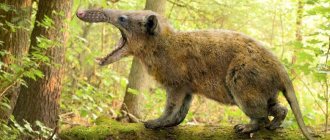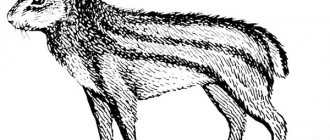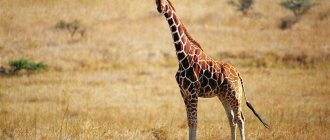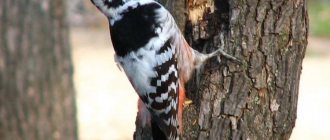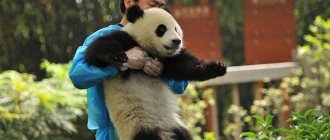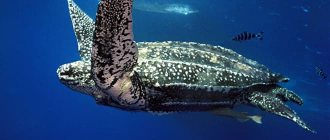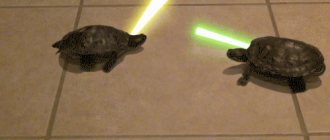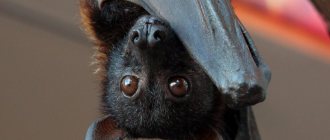kwiktor/Getty Images
Arizona girdlings (Heloderma suspectum) are the only venomous lizards found in the United States and the largest lizards north of the Mexican border. Although they have a good reputation, much of what you have heard about these animals is most likely incorrect or at least exaggerated.
Discover 10 surprising facts about Arizona snake teeth, amazing animals that bite scary but can also help save lives.
Description
The Arizona horned lizard is one of two species of venomous lizards in the world (the other is the Mexican horned lizard or tola hini, (Heloderma horridum)). Vessels are massive and obese lizards with a short tail, in which fat reserves are deposited. The maximum body length of the Arizona horned tooth, including the tail, is 60 centimeters, with the tail making up 20% of the total length. The body is scaly, the color contains yellow, pink and black. The tongue is large and forked at the end. The Vipertooth has a wide head and a pronounced chin. The neck, legs and feet are black. Small black eyes with movable eyelids. The opening of the ear is a narrow, oblique or ovoid slit. The lizard's limbs are strong and equipped with strong claws. Body weight, as a rule, is in the range of 350 – 700 g. The weight of the largest lizard was 2.3 kg.
Komodo dragon (giant Indonesian monitor lizard, Komodo dragon)
Komodo dragons from the Varan family are considered to be the largest and most dangerous lizards in the world - some representatives of the species grow up to three meters or more, and weigh from 100 to 130 kg. The average body length is from 2.25 to 2.6 m, weight is from 35 to 60 kg. The size of males is significantly larger than that of females.
They are distinguished not only by their size, but also by their color - the orange-red or yellowish spots on the body of a young monitor lizard become darker with age, acquiring a brown color. Small yellowish spots and specks are scattered throughout the lumpy body.
This species of monitor lizard is one of the most ancient. The remains of animals that lived 3.8 million years ago have been found. Nowadays it lives on the Indonesian islands, where there are about 6,000 individuals.
Nutrition, environment, lifestyle
You can meet dangerous giant lizards on dry plains heated by the sun, in savannah areas, and in dry tropical forests. In the heat of the day, they prefer to hide, appearing in the early morning and evening, when the heat begins to subside. Burrows up to 5 m long are dug with paws equipped with strong curved claws.
Until the monitor lizard grows up, it is able to easily climb trees, where it spends most of its time in search of food or hiding from danger. His enemy is an adult monitor lizard, which will not refuse to eat a small relative, a bird of prey, a snake.
When the cub grows up, it is more difficult for him to climb a tree, so if he needs to get food from the tree, he rises on his hind legs and rests his tail on the ground, jumping. Acute vision, olfactory organs located on the tongue, and excellent hearing help sense prey. The predator can detect the smell of carrion and the blood of a wounded animal at a distance of more than 10 km. The giant does not have a vocal apparatus, so the sounds it makes are similar to hissing, hissing, and growling.
While the monitor lizard is small in size, it feeds on insects, small invertebrates, fish, turtles, snakes, and rodents. In adulthood, it switches to large animals, which are sometimes several times larger than it.
Opening its mouth wide, the predator uses its sharp teeth to grab part of the victim’s flesh, tear it out and swallow it. If the prey is small in size, it swallows it whole. The weight of food eaten is 70-80% of body weight.
The reptile lies in wait for large prey and attacks, knocking it down with a blow of its powerful tail, then cuts the tendons on the legs with its teeth, depriving the victim of the ability to move. Then he inflicts multiple lacerations on the neck and stomach, and the animal dies from blood loss.
There is an opinion that when bitten, the monitor lizard injects a toxin along with saliva, which contributes to a faster death of the victim. Toxins are produced by glands located on the lower jaw.
If the wounded animal managed to escape, then the predator pursues the prey, developing a speed of up to 20 km/h over short distances, and over a long distance the speed is lower - up to 10 km/h. After the victim weakens and cannot move further, the monitor lizard eats it.
Reproduction
The ability to procreate in a monitor lizard occurs in the fifth to tenth year of life. There are more males than females, so you have to fight for the right to possess a female. The mating period occurs during dry times, i.e. in winter.
The female often makes a hole for laying in the nests of weed hens, which nest them in a pile of fallen leaves. As a result of the decay of plant debris, the required temperature is maintained in the burrow. On average there are about 20 eggs in a clutch. The female lays eggs in the summer (June-July), and the cubs appear in the spring (April-May). Until the moment they appear, the mother guards the clutch, and then the offspring immediately enters an independent life.
Danger to humans
Komodo dragons are aggressive and dangerous animals that can attack and bite. Cases of fatal attacks on people have been recorded. Even with a small bite, the lizard's teeth tear out a piece of meat, which causes large loss of blood. Often the wound gets infected, leading to blood poisoning.
Reproduction
Puberty occurs at the age of 3-5 years. Arizona snake teeth emerge from hibernation in January-February and mate in May-June. When the male finds a female, he lies down on her, rubs his chin on her back and fixes her with his hind legs. If the female is not interested in the male, she will try to bite him and free herself. If she is receptive to his advances, she raises her tail. The male then moves his tail underneath her, resulting in the act of copulation. The male has two penises (hemipenis), but only one is used during reproduction. Mating lasts from 15 minutes to 2.5 hours. In July or August, the female lays eggs, from 1 to 12 pieces, in underground cracks or buries them in the ground to a depth of 13 cm.
The incubation period, on average, lasts about nine months, and the cubs are born in April-June of the following year. The reproductive process, from mating to the appearance of the cubs, lasts about a year. The body length of a hatched hawk tooth is about 16 cm and they can immediately bite and inject their venom into the victim. After laying eggs, adult females gradually reduce their time on the surface to avoid the hottest period of summer (although they can be active in the evening), eventually going into hibernation in November.
Lifestyle of a poisonous lizard
In the territory that the lizard has chosen for its further residence, it digs holes or occupies the holes of other animals. Holding its body on outstretched limbs, the poisonous tooth moves very slowly, dragging its thick tail along the surface of the earth.
Up close, the skin of the poisonous tooth resembles a massage mat.
In general, the activity of this type of lizard directly depends not only on the time of day, but also on the season of the year. Since snake teeth are very sensitive to dry air, the most favorable time for them is considered to be the end of winter and spring. It is during this period, when during the day the air temperature warms up to 24 - 27 degrees Celsius, and the humidity reaches 80%, that they are most active during the day.
When drought sets in, and this is the last month of spring and summer, the poisonous teeth lead only a nocturnal lifestyle, which changes with the onset of autumn. It is also worth considering that this is a unique animal - it spends up to 98% of its existence underground. About 180 hours per year are allocated for everything else, such as searching for food and reproduction.
When danger arises, this reptile hides in a hole, however, if the dwelling is far away, the gland hisses and snorts dully, trying in this way to scare off the enemy. And only if all else fails, poisonous teeth are used.
The poison tooth is a nocturnal animal.
Very often, after being bitten, poisonous teeth die. The venom of these reptiles acts in the same way as the venom of snakes, that is, the nervous system is damaged. If a person is attacked, then subsequently, the bite of a poisonous tooth is accompanied by very painful sensations, as well as loss of consciousness.
Nutrition
The diet of a poisonous lizard consists of: small mammals (young rabbits, mice and squirrels), birds, lizards and eggs (birds, lizards, snakes and turtles). The dweller has the ability to consume a large amount of food at one time (young individuals consume up to 50% of their weight in one meal, and adults - up to 35%). This is an advantage in the wild, where regular feeding at regular intervals is virtually impossible. In its natural habitat, the serpentine eats rarely, 5-10 times a year. Lizards rarely release their venom on prey, suggesting that it is used primarily for defense. Like most snakes, the lizard uses its tongue for smell. Its sense of smell is so strong that it can find and dig up eggs at a depth of up to 15 cm.
If the victim is large, he kills it, and if it is small, he eats it alive. In search of eggs, Arizona vultures are able to climb trees and cacti.
The Arizona hawksbill only needs to eat a few times a year.
These large lizards raid nests to eat eggs and small birds, and can also catch frogs and small mammals with their powerful bite, killing them with their strong jaws and sharp teeth. They also eat insects and dead animals they encounter. ()
They can eat quite a lot of food, eating up to one-third of their body weight at one time. Because they store fat well and have a low metabolic rate (one reason they are fairly non-aggressive), they don't need to eat much to stay healthy. (, )
Behavior
Little is known about the social behavior of venomous lizards, but males have been observed fighting each other, in which the dominant venomous lizard will lay down on the subordinate and lock its fore and hind limbs. Both males arched their bodies and pushed each other in an attempt to gain dominance.
The struggle ends when they are separated from each other, although they may resume more than once. Such contractions are usually observed before the breeding season. It is believed that individuals that have greater strength and endurance enjoy greater reproductive success. Although Arizona hornbills have a low metabolism and are one of the slowest lizards, they have some of the highest aerobic capacity (rapid increase in oxygen consumption from resting to maximum metabolic load) of any lizard, allowing them to be active for long periods time. It has been observed that males are hardier than females, presumably due to prolonged fighting and mating.
Area
The Arizona horned tooth is found in southwestern Utah, southern Nevada and adjacent San Bernardino County, California, southeastern Arizona, and southwestern New Mexico. It lives in southern Mexico, from the state of Sonora to the northwestern part of the state of Sinaloa. The lizard is found in areas from sea level to 1500 meters above sea level.
Economic value for humans: Positive
The Arizona borer is of little economic importance to humans. There is a small market for hemipenises, which are used as an aphrodisiac. A “pet” market also exists for this species. This is illegal, however, the animals are kept in captivity. Lizards can be found in many zoos.
They have really serious bites
Arizona snake teeth rarely bite people, but if bitten, a person needs medical attention. The bite is reported to be quite painful, and the animal may even work its jaws hard to drive the venom deeper into the affected area. ()
If you are bitten by an Arizona snakebite, try to separate the lizard by opening its mouth with a stick. Then you should rinse the wound with plenty of water, immobilize the affected limb at the level of the heart and immediately seek medical help. ()
The venom of the Arizona serpentine tooth contains a fairly mild neurotoxin that is not fatal to humans. However, it is important that a healthcare professional check the bite for broken teeth, signs of infection, and ensure timely immunization against tetanus. ()
Economic significance for humans: Negative
Due to their slow movements, venetian lizards do not pose a threat to humans, however, they have earned a reputation as a dangerous animal that often kills people. Among the Apache Indians, it was believed that its breath could kill a person, and the Tohono-Oodham believed that the poisonous teeth had spiritual powers that could lead to disease.
FEATURES OF THE DEVICE
Unlike other poisonous reptiles, it is enough for the poisonous tooth to squeeze the victim with its teeth, after which the poison freely drains from the resulting wound. The poisonous glands of the vest developed from the salivary glands. They are up to 4 cm long and are located on the lower jaw under the front poisonous teeth. When a monitor lizard sinks its teeth into prey, poison flows out of the glands and accumulates between its lower lip and gum, from there it enters the cavity of the teeth and, finally, into the body of the victim. When the jaws are strongly compressed, the teeth of the poisonous tooth penetrate to a depth of one centimeter, and the victim captured in this way is unable to prevent the poison from penetrating into the wound made by the teeth. Housing can speed up the animal's dying process by causing multiple bites. Venom tooth bites are painful for humans and cause swelling, but they lead to death only in exceptional cases. The physiological effect of their poison - neurotoxins - is manifested by damage to the central nervous systems and respiration.
Common iguana
The common green iguana has gained immense popularity as a pet; today representatives of this species can be seen in amateur terrariums around the world. Moreover, she can live without a terrarium, just in the house, moving around its entire area.
However, the nature of the reptile is not so flexible, and many of its owners ended up with numerous and difficult to treat wounds. The iguana is excellent at biting and fighting with its claws if it senses danger or is simply not in the mood. The weight of a large individual reaches 7 kg with a height of 1.5 meters, which makes its attack a truly serious circumstance. Is it worth having such exotic pets at home? You should think about this several times before buying an iguana.
INTERESTING FACTS
- The bite of this poisonous lizard caused the death of several people. Whether death occurs depends on the depth of the wound and the amount of poison that gets into it.
- The dwelling is called the “Gila monster” in its homeland because it lives in the Gila River basin (a left tributary of the Colorado). There are many legends about the poisonous tooth, for example, that it is endowed with magical powers and cannot be defeated.
- Eyewitnesses testify that the vest, which has grabbed the victim with its teeth, turns over on its back so that the poison from the lower teeth gets into the wound more quickly.
- Few animals prey on the vest. Only certain types of snakes can cope with it.
CHARACTERISTIC FEATURES OF HOUSING
Body:
flattened, strong, with a large head.
Leather:
tuberous scales. An orange pattern on a dark background camouflages a monitor lizard in the desert among sand and stones.
Claws:
short but sharp; Using these vests, they dig out the eggs of turtles, lizards and snakes from the sand and bury their own eggs.
Language:
with its help, he examines odors and transmits signals to the analyzers of the Jacobson organ located in the oral cavity.
Tail:
short and thick, it stores fat reserves, thanks to which the monitor lizard survives unfavorable periods when there is little food and water (more than 5 months).
— Habitat of the poisonous tooth vest
WHERE IT LIVES
Northwestern Mexico, southwestern United States, mainly Arizona, southeastern Nevada, and southern western Utah.
PROTECTION AND PRESERVATION
Residential habitats may be lost and converted into farmland. These animals are captured for the purpose of being kept in captivity as terarium animals. Both species of vultures are listed in the IUCN Red List of Threatened Species.
